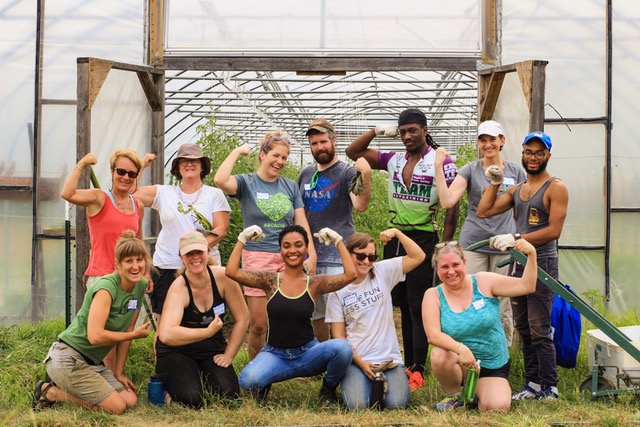Ten Lessons from the Fair Farms Initiative
By: Waterkeepers Chesapeake

By Betsy Nicholas, Executive Director of Waterkeepers Chesapeake
As an environmental lawyer, I was trained to see regulators and courts as the sole path to improvement. But I’ve found that going in with guns blazing and lawyers filing doesn’t get you everything you need, especially when dealing with agriculture. Enforcement actions and stronger permits weren’t enough.
Since 2013, I’ve been working on another path.
That’s when we founded Fair Farms. It’s focused, for now, on Maryland. We hope eventually to grow to include Virginia and Pennsylvania.
As we researched, listened, and thought about what we hoped to achieve, we realized the source of pollution isn’t agricultural run-off. Rather, the source of pollution is a broken food system. Fixing it is a big job.
I had the pleasure of presenting last month at River Rally in Cleveland about what we at Fair Farms have learned over the past six years. I’d like to share those lessons:
- This is going to take time, and it’s going to take money. We were lucky: We got an $85,000 planning grant, and were able to spend two years in planning and focus groups before we moved forward. It was another year-and-a-half before we started seeing real change. But the work didn’t get any cheaper. The campaign, funded by foundations, has an annual budget of around $300,000 a year.
- If you want to talk knowledgeably about farming, you need to talk to farmers. A key lesson was that farmers should be included at the planning table. We were late to do this, and it cost us some time, but we made up for that when we established a Farmer Advisory Council, which gives farmers a chance to share what they’re doing on their farms and helps us determine what issues we’ll focus on and what legislation we’ll push for.
- To talk to farmers, you need to give them incentives to speak with you. A hurdle we faced was how to get farmers off their fields and into meetings with us. One answer: Pay them for their time. We also helped farmers find small loans and grants, connecting one farmer with a $10,000 loan through Kiva.
- Listen. Our farmers didn’t like the Farm Bureau, so they needed another way to connect with each other. We spend a lot of time listening to what people are doing on their farms and discussing how we could spread some of these initiatives statewide. Because we’re shaping our policy proposals around farmer actions, we’re able to get fifty farmers to sign a letter, or three farmers to testify at a hearing. It’s hard to argue we’re anti-agriculture when we have farmers testifying for our proposals at the state house.
- It’s a group effort. In addition to farmers, we eventually brought together scientists, conservation groups, businesses, and public health professionals. We now have 180 partners.
- Understand the level of commitment needed from partners and steering team leaders. We all made the strategic decision to fix the system, rather than focusing on the symptoms. It takes longer, but leads to more meaningful change.
- Win consumers over by giving farmers a chance to tell their stories. These first-person stories are better than a million white papers. Read how Kim Wagner of Black Bottom Farms left nursing for farming after she was diagnosed with Stage 3 breast cancer and was frustrated in her efforts to find cleaner food. Then tell me you wouldn’t want to help her out.
- Talk about solutions. As an attorney, I never thought I’d say this, but we have a great YouTube channel. Our 3.39-minute video about fifth-generation farmer Ron Holter lays out the benefits of regenerative agriculture far better than any half-hour PowerPoint ever could. I can say that every one percent increase in soil’s organic matter helps the soil hold 20,000 more gallons of water for each acre until I’m blue in the face. Everyone will stare at me blankly. But put it on a slide at the end of a video with a bunch of doe-eyed cows and people will remember it for years.
- Bring people in with stories, keep them in with actions. We call it “moving up the ladder of engagement.” The first step is visiting our website. The second is liking or following us on social media. (We have more than 14,300 Facebook followers.) Next is taking a pledge to be a Fair Farms consumer. After that, we’ll ask a supporter to take an action, like writing a letter to a legislator, or a letter to the editor, or testifying in person at a hearing.
- Make some of those actions fun. The last rung on the ladder of engagement is attending an event. We showed the movie “Dirt” at Dirty Movie Night. Some of our farmers host Weed and Wine events, where supporters pull weeds from the fields and drink wine. Our policies give supporters something clear to work for; our activities give them a sense of fellowship in that work.

We’ve had more success in two-and-a-half years of happy storytelling than we did in the previous ten years of hard-nosed litigation. Last legislative session, Maryland passed a law restricting antibiotic use in livestock and poultry when animals are not sick and requiring the collection of important data regarding antibiotic use on farms. This is the strongest law of its type in the entire country.
The state also committed $100,000 a year to the Farms and Families Fund, supporting farmers market incentive programs in which federal nutrition benefits are matched dollar for dollar.
These wins were only possible because we had partner farmers who pushed for them. Nurturing those partnerships wasn’t quick, cheap, or easy, but it’s some of the most gratifying work I’ve ever had the privilege of doing.